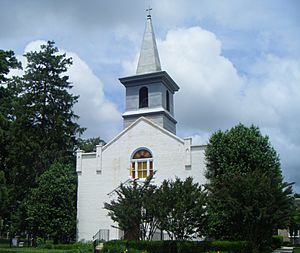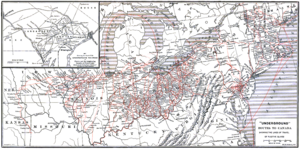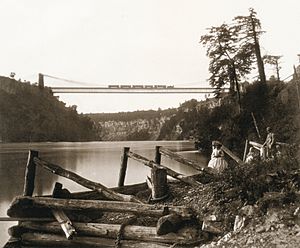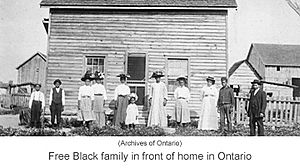Anna Maria Weems facts for kids

Anna Maria Weems (born around 1840) was an American girl famous for escaping slavery. She dressed up as a boy carriage driver and traveled all the way to Canada, where her family found freedom. She used different names like "Ellen Capron" and "Joe Wright" to stay hidden.
When she was about seven years old, Anna Maria and her younger sister were separated from their family. Her mother and brothers were sold to a different owner far away in Alabama. Luckily, within a few months, her mother and two youngest brothers were freed and joined their father in Washington, D.C.. Then, Anna Maria's sister, Catherine, also gained her freedom. The Weems family got money to buy their freedom from people who supported ending slavery in England and the United States.
However, they couldn't buy Anna Maria's freedom. So, at age 15, she decided to escape. She left her slaveholder in Rockville, Maryland and traveled through Philadelphia, Washington, D.C., and Brooklyn, New York. Her journey ended in Dresden, Ontario, Canada. This trip was very dangerous because of a law called the Fugitive Slave Act of 1850, which made it harder for enslaved people to escape. Her journey took over two months, and she spent six weeks of that time hiding, mostly dressed as a young man.
Three books have been written about Anna Maria Weems and her family's fight for freedom: A Shadow on the Household, Stealing Freedom, and The Underground Railroad: Anna Maria Weems.
Contents
Anna Maria's Early Life
Anna Maria Weems was born in Maryland around 1840. Her father, John, was a free man, but her mother, Arabella Talbot Weems, was enslaved by a man named Adam Robb. Arabella was described as a very smart and talented woman. Anna Maria's grandmother, Cecelia Talbot, was also enslaved by Robb. They all lived in Montgomery County, Maryland, where Robb owned a tavern and an inn.
It was rare for an enslaved woman to marry, but Arabella married John on March 1, 1829, at St. Mary's Roman Catholic Church in Rockville, Maryland. John bought his own freedom before they got married. Robb had promised John that he could buy his wife and children for a fair price. Sometimes, Robb even allowed the family to live together.
John and Arabella Weems had ten children: Mary Jane, Catherine Ann, William Augustus, Thomas Richard, Charles Adam, Anna Maria, Joseph, John Lewis, Sylvester, and Mary. All their children, except the youngest, Mary, were born into slavery. Arabella became a free woman before Mary was born. Anna Maria Weems was baptized at St. Mary's Church.
In 1847, when Anna Maria was about five or seven years old, Adam Robb died. His enslaved people were divided between his two daughters, Jane Robb Beall and Catherine Robb Harding. Anna Maria, her siblings, and her mother went to Catherine Robb Harding. However, Catherine and her husband, Henry Harding, were in a lot of debt. They planned to sell enslaved people to solve their money problems. John tried to raise money to buy his family members, but he couldn't do it before they were separated.
Harding sold Anna Maria's mother and sons to slave traders. They were held in a jail in Washington, D.C., before being sent to Alabama. Anna Maria and her sister Catherine were sold to Charles M. Price, a slave trader in Unity, Maryland. William Still, a famous abolitionist, described Charles Price as someone who used bad language.
Around 1849 or 1850, an abolitionist named William L. Chaplin helped Anna Maria's oldest sister, Mary Jane, and her aunt Annie and her family escape. Mary Jane went to Geneva, New York, and was adopted by Henry Highland Garnet, a former enslaved person and abolitionist. Mary Jane changed her name to Stella. Her aunt and uncle became Annie Bradley and William Henry Bradley. Stella later moved to Jamaica in 1852.
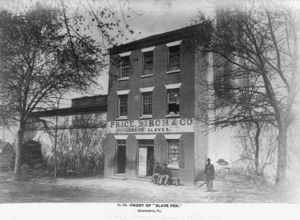
People heard that the Weems family would likely be sold to different owners. So, a special fund called the Weems Family Ransom Fund was created. Most of the money came from Henry and Anna Richardson, who were Quaker abolitionists from England. The goal was to help John buy his wife Arabella and their children's freedom. More than $5,000 was raised.
Jacob Bigelow, a lawyer from Washington, D.C., managed to buy the freedom of Arabella and two of her sons for $1,600 after a few months. John, Arabella, and the two boys then settled in Washington, D.C. Their daughter Catherine was also freed after a payment of $1,000 or $1,600. She found work in Washington, D.C.
However, there wasn't enough money left in the fund for an offer that Price would accept to sell Anna Maria. For years, the Prices refused any offers from Bigelow to sell her, even when the offer reached $700. To prevent her from escaping, when Anna Maria was 10 or 15 years old, she had to sleep in the Prices' bedroom.
Anna Maria's Escape Plan
Anna Maria Weems planned her escape from the Prices for more than two years. Jacob Bigelow helped her plan with William Still, who was a "conductor" on the Underground Railroad. Still was also part of the Philadelphia Vigilance Committee. Another helper was Rev. Charles Bennett Ray from the New York Vigilance Committee.
Conductors like Still helped people escaping slavery travel between "stations" on the Underground Railroad. At these stations, they would get food and a place to sleep before moving to the next safe spot. The journey was very dangerous for Anna Maria and those who helped her, especially after the Fugitive Slave Act of 1850 was passed. This law made it very risky to stay in Washington or other parts of the United States. So, the goal was to get her safely to a settlement in Dresden, Ontario, Canada, where her aunt and uncle had already found safety.
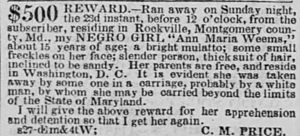
On September 23, 1855, at age 15, Anna Maria escaped the Price household in Rockville. She traveled 15 miles to Washington, D.C. She might have stayed with family members there for a short time before meeting Jacob Bigelow, who was also an Underground Railroad conductor. A newspaper ad was put out about her escape, offering a $500 reward for her capture. The ad described her as "A bright mulatto, some small freckles on her face; slender person, thick suit of hair, inclined to be sandy."
Because of the large reward, Anna Maria had to hide in Bigelow's house for six weeks. During this time, they created a plan to disguise her as "Mr. Joe Wright," a male carriage driver. She wore a driver's uniform, a cap, and a bow tie. She was also taught how to walk and act like a young man.
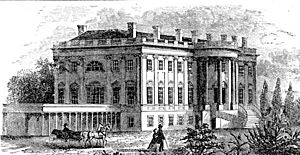
Bigelow's white doctor, Dr. Ellwood Harvey ("Dr. H."), helped her escape Washington, D.C. He drove his carriage to the White House, where he met Anna Maria, who had been brought there by Bigelow. Anna Maria took the driver's seat and drove out of the city. Along the way, they met toll gate operators and ferry operators who questioned them. They stopped for several days at the homes of Dr. H's friends, who were slaveholders. Dr. H made jokes that "Joe" might be a runaway and then claimed to have dizzy spells that required "Joe" to sleep in his room, which kept Anna Maria safe.
On their second day, Dr. Harvey handled a situation where several men tried to stop them after they crossed the Susquehanna River. They finally reached William Still's house in Pennsylvania on November 22, 1855. There, a photograph was taken of Anna Maria in her disguise to send to her mother. In his report for the Underground Railroad, Still described her: "She is about fifteen years of age, bright mulatto, well grown, smart, and good-looking."
Anna Maria stayed at the Still's house for several days before being taken to New York. On November 28, Rev. Charles Bennett Ray escorted her to meet abolitionist Lewis Tappan and his wife, Sarah Tappan, in Brooklyn. She stayed with them for several days, and Sarah bought her new clothes suitable for the Canadian weather, using $63 from the Weems Ransom Fund.
Next, she was taken to the home of Rev. Amos Noë Freeman, a minister in Brooklyn. At the Freeman's house, she received a warm welcome, typical of the Underground Railroad. Freeman then took Anna Maria to Canada by train, traveling through Rochester, New York, and Niagara Falls. Once in Canada, they traveled by train to Chatham. From there, they were taken by carriage to the Dawn settlement for former enslaved people in Dresden, Ontario, Canada. This was where her aunt and uncle, William Henry and Ann Bradley, had found safety. The Bradleys chose these new first names after gaining their freedom. Anna Maria's long journey ended in December 1855, two months after it began.
Life in Freedom
In Canada, Anna Maria was educated at the Buxton Mission at the Elgin Settlement (now Buxton National Historic Site and Museum). This settlement, located about twelve miles south of Chatham, Ontario, was one of four communities in Canada established for Black people.
The Buxton settlement was a large area of 9,000 acres. It offered education through the Buxton Mission School and religious services to its residents, most of whom had been enslaved. The land was divided into 50-acre farms that people could pay for over ten years. The community also had a brick-making plant, a general store, a mill for grinding grain, and a saw mill. Over time, it grew to include a hotel, a post office, and other businesses. In 1856, 120 students attended the mission school. The education there was so good that it was called "the most successful black settlement in North America." The local school for white children even closed, and those children transferred to the Buxton school to get a better education. Students from Buxton went on to become politicians, doctors, teachers, and missionaries.
Anna Maria settled at Buxton. Her parents, John and Arabella, had a daughter named Mary, who was born free around 1855. The family was able to reunite with their other children. The remaining two sons, James and Addison, who were still enslaved, were bought with money from the Weems Family Ransom Fund by August 1858. Anna Maria's mother wrote to William Still in 1857, saying she was expecting her son Augustus, who was the last family member still enslaved. She had raised more money herself to help free him. She wrote, "I am expecting daily the return of Augustus, and may Heaven grant him a safe deliverance and smile propitiously upon you and all kind friends who have aided in his return to me."
John and Arabella moved to the Dawn settlement in 1861 with their two youngest children, just before the American Civil War began. They lived there for nine years before returning to Washington, D.C., where John, Arabella, their son John, and daughter Mary were living by June 1870.
Why Anna Maria's Story is Important
Historians like Stanley Harrold say that Anna Maria Weems's story shows how important gender was in her escape. Her disguise as a boy was key to her success. Her case also highlights how people from different countries and different races worked together to help enslaved people escape, even though they faced serious risks if caught. Her story helps us understand the bravery and cooperation involved in the Underground Railroad.


